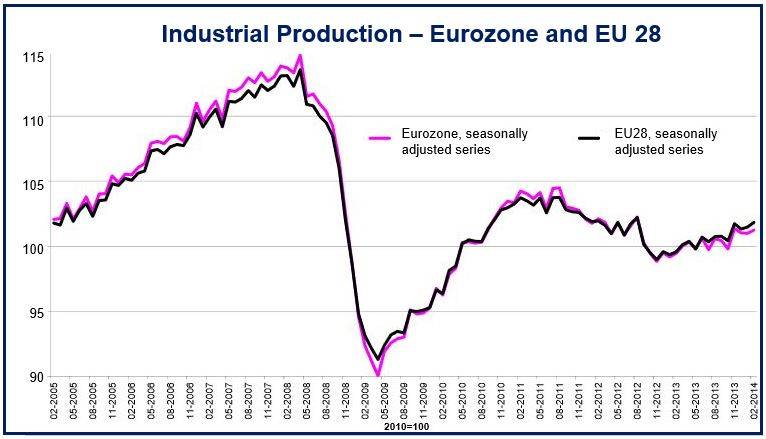February Eurozone industrial production was 0.2% higher than in January, according to Eurostat, the statistical office of the European Union. In the whole of the European Union, including countries that do not use the euro as their national currency, February industrial production increased by 0.4%.
In January 2014, industrial production in the 18-national Eurozone had remained stable, and had risen by 0.2% in the whole European Union trading block consisting of 28 countries (EU28).
February Eurozone industrial production was 1.7% higher compared to February 2013, and 2.1% higher over the same period in the EU28.
Intermediate and non-durable consumer goods up
February’s industrial production increase in the Eurozone was driven by a 0.6% rise in the production of intermediate goods and a 0.5% increase in non-durable consumer goods. Durable consumer goods dropped by 1.2%, energy declined by 1.7%, and capital goods remained stable.
The EU28’s 0.4% February increase was due to a rise of 0.9% in the production of non-durable consumer goods, a 0.5% increase in intermediate goods, 0.2% more capital goods, and a fall in consumer goods and energy, by 0.7%, and 1.4% respectively.
The greatest increases in industrial production in February 2014 occurred in Malta +5.4%, Ireland +5%, and Lithuania +2.5%. The largest declines were registered in Croatia -2.8%, Estonia -2.2% and Romania -1.3%.
(Source: Eurostat)
Feb 2014 vs. Feb 2013 Industrial production comparisons
In the Eurozone, February 2014 compared to February 2013 as follows:
- Industrial production: +1.7%.
- Intermediate goods: +4.2%.
- Capital goods: +4.0%.
- Non-durable consumer goods: +2.8%.
- Durable consumer goods: (minus) -0.6%.
- Energy: (minus) -8.5%.
In the EU28, February 2014 compared to February 2013 as follows:
- Industrial production: +2.1%.
- Intermediate goods: +4.6%.
- Capital goods: +4.5%.
- Non-durable consumer goods: +2.7%.
- Durable consumer goods: +1.5%.
- Energy: (minus) -7.2%.
The greatest increases in industrial production occurred in Slovakia +9.0%, Romania +8.9% and Hungary +8.2%, while the largest declines were registered in the Netherlands -8.9%, Finland -5.4% and Lithuania -2.1%.
The BBC quoted Howard Archer, IHS Global Insight’s chief European and UK economist, who said:
“A modest increase in industrial production in February supports [the] belief that Eurozone economic recovery is continuing to gradually firm. It looks likely that industrial production saw reasonable if unspectacular growth across the Eurozone in the first quarter and made a positive contribution to GDP growth.”
Eurozone deflation fear
There has been growing concern that the Eurozone could slide into a deflationary recession as the currency bloc’s inflation rate drifts each month further away from the European Central Bank’s (ECB’s) target of 2% per year.
ECB President, Mario Draghi, announced during the weekend that if the euro continues to rise and inflation carries on falling, the ECB might consider a looser monetary policy, including quantitative easing or a negative benchmark interest rate.
In a news conference in Washington D.C. on Saturday, Mr. Draghi said:
“The strengthening of the exchange rate would require further monetary policy accommodation. If you want policy to remain as accommodative as now, a further strengthening of the exchange rate would require further stimulus.”
Written by [google_authorship]


